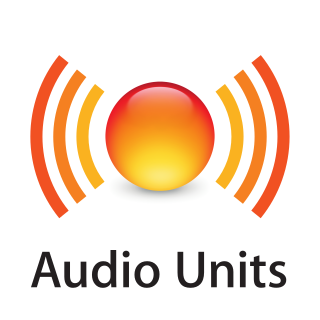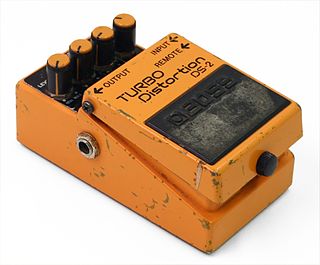
An effects unit or effects pedal is an electronic device that alters the sound of a musical instrument or other audio source through audio signal processing.
QuickTime is a discontinued extensible multimedia framework created by Apple, which supports playing, streaming, encoding, and transcoding a variety of digital media formats. The term QuickTime also refers to the QuickTime Player front-end media player application, which is built-into macOS, and was available for download on Windows until 2016.

The iPod is a series of portable media players and multi-purpose mobile devices designed and marketed by Apple Inc. The first version was released on October 23, 2001, about 8+1⁄2 months after the Macintosh version of iTunes was released. Apple sold an estimated 450 million iPod products as of 2022. Apple discontinued the iPod product line on May 10, 2022. At over 20 years, the iPod brand is the oldest to be discontinued by Apple.

Virtual Studio Technology (VST) is an audio plug-in software interface that integrates software synthesizers and effects units into digital audio workstations. VST and similar technologies use digital signal processing to simulate traditional recording studio hardware in software. Thousands of plugins exist, both commercial and freeware, and many audio applications support VST under license from its creator, Steinberg.

GarageBand is a line of digital audio workstations developed by Apple for macOS, iPadOS, and iOS devices that allows users to create music or podcasts. GarageBand was originally released for macOS in 2004 and brought to iOS in 2011. The app’s music and podcast creation system enables users to create multiple tracks with pre-made MIDI keyboards, pre-made loops, an array of various instrumental effects, and voice recordings.
The Environmental Audio Extensions are a number of digital signal processing presets for audio, present in Creative Technology Sound Blaster sound cards starting with the Sound Blaster Live and the Creative NOMAD/Creative ZEN product lines. Due to the release of Windows Vista in 2007, which deprecated the DirectSound3D API that EAX was based on, Creative discouraged EAX implementation in favour of its OpenAL-based EFX equivalent – though at that point relatively few games used the API.

RealPlayer, formerly RealAudio Player, RealOne Player and RealPlayer G2, is a cross-platform media player app, developed by RealNetworks. The media player is compatible with numerous container file formats of the multimedia realm, including MP3, MP4, QuickTime File Format, Windows Media format, and the proprietary RealAudio and RealVideo formats. RealPlayer is also available for other operating systems; Linux, Unix, Palm OS, Windows Mobile, and Symbian versions have been released.

Audio Units (AU) are a system-level plug-in architecture provided by Core Audio in Apple's macOS and iOS operating systems. Audio Units are a set of application programming interface (API) services provided by the operating system to generate, process, receive, or otherwise manipulate streams of audio in near-real-time with minimal latency. It may be thought of as Apple's architectural equivalent to another popular plug-in format, Steinberg's Virtual Studio Technology (VST).
ReplayGain is a proposed technical standard published by David Robinson in 2001 to measure and normalize the perceived loudness of audio in computer audio formats such as MP3 and Ogg Vorbis. It allows media players to normalize loudness for individual tracks or albums. This avoids the common problem of having to manually adjust volume levels between tracks when playing audio files from albums that have been mastered at different loudness levels.

The iPod Shuffle is a discontinued digital audio player designed and formerly marketed by Apple Inc. It was the smallest model in Apple's iPod family, and was the first iPod to use flash memory. The first model was announced at the Macworld Conference & Expo on January 11, 2005; the fourth- and final-generation models were introduced on September 1, 2010. The iPod Shuffle was discontinued by Apple on July 27, 2017.

Logic Pro is a proprietary digital audio workstation (DAW) and MIDI sequencer software application for the macOS platform developed by Apple Inc. It was originally created in the early 1990s as Notator Logic, or Logic, by German software developer C-Lab which later went by Emagic. Apple acquired Emagic in 2002 and renamed Logic to Logic Pro. It is the second most popular DAW – after Ableton Live – according to a survey conducted in 2015.
The Motorola ROKR, the first version of which was informally known as the iTunes phone, was a series of mobile phones from Motorola, part of a 4LTR line developed before the spin out of Motorola Mobility. ROKR models were released starting in September 2005 and ending in 2009. They were notable for incorporating support of media player features.

Distortion and overdrive are forms of audio signal processing used to alter the sound of amplified electric musical instruments, usually by increasing their gain, producing a "fuzzy", "growling", or "gritty" tone. Distortion is most commonly used with the electric guitar, but may also be used with other electric instruments such as electric bass, electric piano, synthesizer and Hammond organ. Guitarists playing electric blues originally obtained an overdriven sound by turning up their vacuum tube-powered guitar amplifiers to high volumes, which caused the signal to distort. While overdriven tube amps are still used to obtain overdrive, especially in genres like blues and rockabilly, a number of other ways to produce distortion have been developed since the 1960s, such as distortion effect pedals. The growling tone of a distorted electric guitar is a key part of many genres, including blues and many rock music genres, notably hard rock, punk rock, hardcore punk, acid rock, and heavy metal music, while the use of distorted bass has been essential in a genre of hip hop music and alternative hip hop known as "SoundCloud rap".

TC Electronic is a Danish audio equipment company that designs and imports guitar effects, bass amplification, computer audio interfaces, audio plug-in software, live sound equalisers, studio and post-production equipment, studio effect processors, and broadcast loudness processors and meters. In August 2015, the company was purchased by Music Tribe, a holding company chaired by Uli Behringer.
In computer music and professional audio creation, a DirectX plugin is a software processing component that can be loaded as a plugin into host applications to allow real-time processing, audio effects, mixing audio or act as virtual synthesizers. DirectX plugins allow the replacement of traditional recording studio hardware and rack units used in professional studios with software-based counterparts that can be connected together in a modular way. This allows host manufacturers to focus on the conviviality and efficiency of their products while specialized manufacturers can focus on the digital signal processing aspect. For example, there are plugins for effects boxes, such as reverbs and delays, effects pedals, like guitar distortion, flange and chorus, and for mixing and mastering processors such as compressors, limiters, exciters, sub bass enhancers, stereo imagers and many more.

Logic Studio is a discontinued professional music production suite by Apple Inc. The first version of Logic Studio was unveiled on September 12, 2007. It claims to be the largest collection of modeled instruments, sampler instruments, effect plug-ins, and audio loops ever put in a single application.

MusicBee is a freeware media player for playback and organization of audio files on Microsoft Windows, built using the BASS audio library.
Source Audio is a guitar effects pedal company based near Boston, Massachusetts. They produce modular effects pedals for electric guitar and bass, such as the Nemesis Delay, Ventris Dual Reverb, and Collider Delay+Reverb, as well as the C4 Synth, a modular rack synthesizer in pedal format, the Aftershock Bass Distortion, and the EQ2, a 10-band parametric equalizer with a plug-in style desktop interface. They are also the creators of the Hot Hand Wireless Effects Controller, a device worn around the finger that uses an accelerometer to send expression signal to an effect like an envelope filter. Source Audio mainly uses DSP to create their effects, and are known to program their own processor chips.

Magnus Choir is a commercial, proprietary music software synthesizer, for the Microsoft Windows and macOS operating systems, written by Daniel Laiseca and developed by Syntheway Virtual Musical Instruments. The first version was released in 2005.












